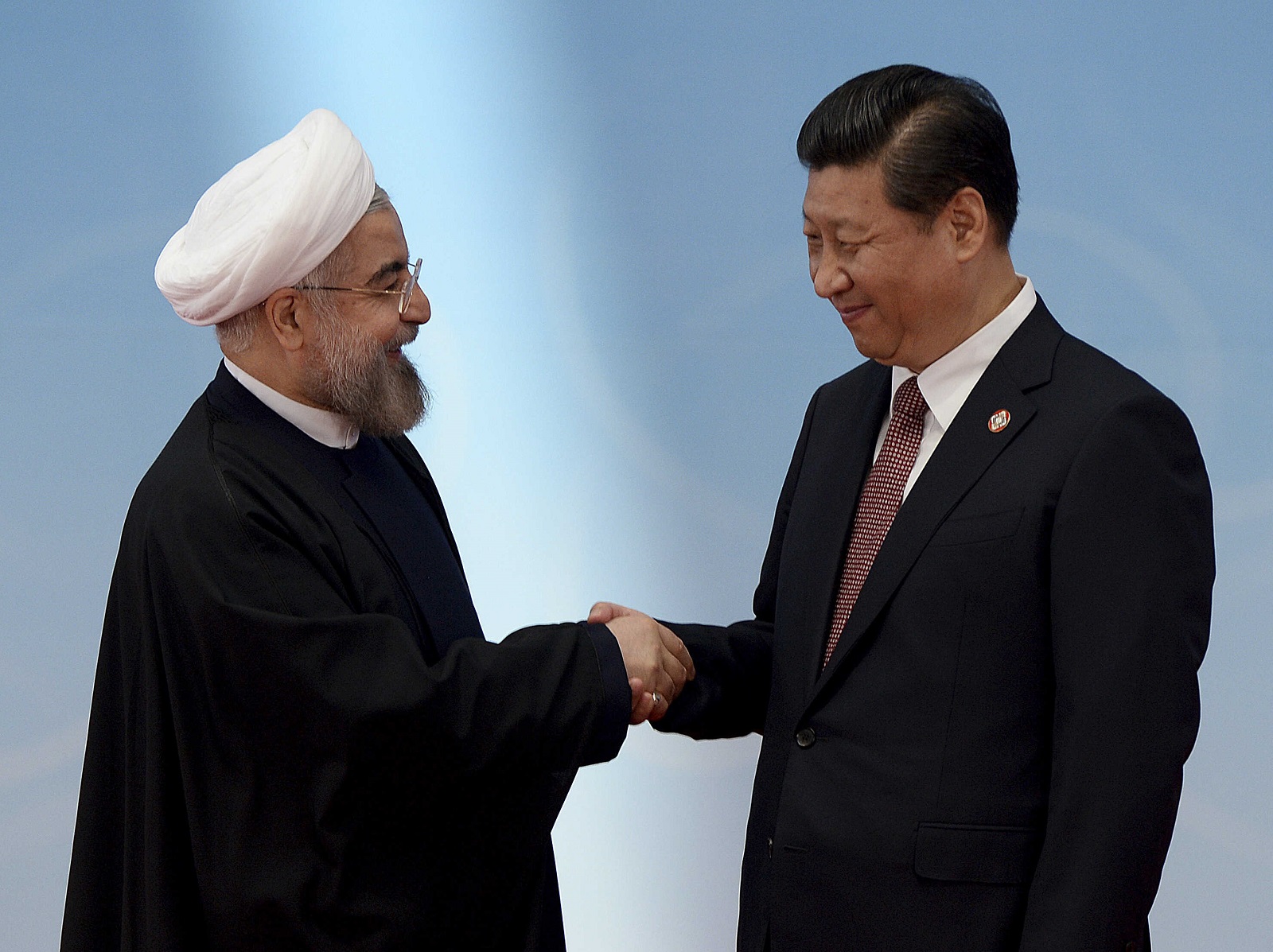
The recent 25 Year Iran-China Strategic Cooperation Agreement has stirred up a great deal of attention and controversy in both Iran and the United States. In America, it has been met with great fanfare by foreign policy analysts, who trumpet it as a major shift in China’s Iran policy worth $400 billion dollars. Critics decry it as the result of Biden’s appeasement of Iran and claim that it poses a fundamental challenge to U.S foreign policy. Others charge that Trump’s policy of maximum pressure is to blame for driving Iran into the arms of China. In Iran, proponents hail it as an alternative to the West and a defeat to American policy, while opponents express fears of overdependence and rumors spread that Iranian territory is up for sale.
In truth, the deal is much less of a major event than it is being made out to be. A growing number of Iran-China experts have pointed out that the agreement is non-binding, includes no specific contracts or proposals, and most importantly, contains no mention of any monetary figure, let alone $400 billion. Although the text has not been released, a leaked draft appeared last summer, and little appears to have changed since then. Both the Iranian and Chinese Foreign Ministries have called the agreement a “non-binding document” and a “roadmap” for future cooperation. Chinese officials insist it is not targeted at any specific country, and that its implementation is contingent on further improvements in U.S-Iran relations.
Iran-China Relations in Recent Years
Sino-Iranian relations have been steadily increasing over recent decades. Since 2000, China has drilled wells for oil and gas in southern Iran, received billions in oil and gas contracts, constructed several pipelines around the country, invested in developing Caspian Sea oil resources, and increased trade exponentially, reaching a height of around $30 billion in 2016. Chinese construction companies have contributed to numerous projects across Iran, including the Tehran Metro, and China has been a critical “oil sink” for Iran during a time when sanctions make it difficult to sell oil on the international market. Some Belt and Road initiative projects further link Iran to China by rail and sea, and the two even held joint naval exercises in 2017. China has also established numerous cultural and educational links between Chinese and Iranian universities and museums.
However, Sino-Iranian relations have also had moments of instability and friction. As early as 1997, Tehran suspended its nuclear cooperation with Iran under the threat of American sanctions. Over the next few decades it repeatedly cancelled deals under U.S pressure, and even occasionally voted in favor of sanctions against Iran.
More recently, in 2019, Chinese state oil company CNPC pulled out of a $5 billion dollar contract to develop the South Pars oil field, a repeat of a similar incident in 2012 with the same company.
For some, Chinese goods also have a bad reputation in Iran, a result of the flood of low-quality Chinese products to Iran since the mid-2000s. Since 2016, and especially since the collapse of the JCPOA, oil sales and trade figures have fallen dramatically, down to roughly $14 billion in 2020, and a 35% drop from the year before. This was despite clear and obvious signs that a Sino-Iranian Comprehensive Strategic Agreement was in the works and would likely be concluded soon.
There may be issues ahead when it comes to attracting further investment. In the official Fars News agency, the agreement was described as “somewhat ambiguous, and on the other hand, in some cases, Iran has had bitter experiences in dealing with other countries. It has pros and cons.” Chinese investors are “encouraged” to invest in Iran, but China has yet to commit to specifics, and in the past has not rushed to invest in Iran’s existing free trade zones. Both Chinese and Iranian businessmen grumble in private about the difficulty of dealing with the bureaucracy of the other side, as well as the complications created by the sanctions. While these issues are not insurmountable, the agreement does not guarantee a major and significant amount of investment forthcoming from China, and certainly not the $400 billion predicted.
Sold to China?
Media coverage surrounding the agreement has been subject to inaccuracies, misreporting, and social media rumors run wild. The $400 billion dollar figure comes from an article in the magazine Petroleum Economy, owned by Gulf Energy Information, which has since been taken offline and cited anonymous sources. This same article also claimed that the Agreement “will include up to 5000 Chinese security personnel on the ground in Iran to protect Chinese projects.” When the draft of the deal leaked, no such numbers or mention of Chinese troops was present. Since then, the rumors have intensified, especially on American social media websites, and have included claims that Chinese nuclear waste will be dumped in Iranian deserts, that islands will be sold to China, that permanent military bases will be set up, and that “crime-ridden Chinatowns” will spring up around the country. These accusations, which in some caes draw on stereotypes and xenophobia, are all completely without basis on any evidence.
Iran is also not the only country in the region that China has concluded a Strategic Comprehensive Agreement with. Similar deals have been concluded with Egypt, Saudi Arabia, Qatar, and the UAE. Globally, China has dozens of such “Comprehensive Strategic Partnerships”, including with Russia, Pakistan, Germany, Great Britain, Belarus, Cambodia, Chile, Laos, Myanmar, Republic of the Congo, Thailand, Vietnam, Algeria, Argentina, Australia, Brazil, Ecuador, France, Greece, Indonesia, Italy, Malaysia, Mexico, New Zealand, Peru, Poland, Portugal, Serbia, South Africa, Spain, Uzbekistan, and the EU, and lower level “Strategic Partnerships” with dozens of others. While these agreements do facilitate economic and political cooperation, they clearly do not on their own guarantee a significant partnership. Furthermore, China will have to balance its interests and commitments in Iran with its commitments to other countries.
In fact, Sino-Iranian relations have lagged behind Iran’s neighbors in recent years. Saudi Arabia, Iraq and the UAE have Comprehensive Strategic Agreements with China already. Relations with Saudi Arabia are particularly important, as they provide more than 16% of China’s total oil imports and are the largest single supplier – compared to Iran, which supplies only a fraction of this amount, and at great financial risk due to sanctions. The defense and military agreements that are discussed in the deal, from sharing of intelligence related to terrorism and trafficking to joint military exercises, are already carried out with many other countries in the region. Contrary to the alarmist predictions of Western analysts, this deal represents an attempt to bring Sino-Iranian relations to the same level as other countries in the Middle East.
Future Trajectory
It is clear now that the 25-Year Iran-China Strategic Comprehensive Agreement does not represent a momentous shift in Chinese strategy, nor does it signal the incredible levels of investment predicted by some analysts. Improvement in relations with Iran will have to be balanced against China’s significant relations with other countries in the region, and with the United States, as well as China’s limited resources. It is estimated that over the next five years, China will invest $600-$800 billion dollars globally in the Belt and Road initiative. With so many commitments and the history of on-and-off investment, an investment of $400 billion in Iran alone seems unrealistic.
This does not mean that news of improved Sino-Iranian relations is “fake news” or has no significance. Iran and China are likely to grow closer, especially if the JCPOA is resumed. The real problem that hawkish analysts have with improved Sino-Iranian relations is no mystery: it runs counter to the strategy of “Maximum Pressure” through a cruel policy of wide-ranging sanctions that have primarily harmed the Iranian people. Both sides have acknowledged that the sanctions are a serious barrier to the implementation of the agreement, and that improved Sino-Iranian relations are contingent on improved U.S-Iran relations. It is likely that China will pressure both sides to return to the agreement. All the signatories, including Iran, the U.S, and China, will meet in Vienna next week to discuss the removal of sanctions and the resumption of inspections. The outcome, however, remains uncertain.
 Dr. William Figueroa is a recent graduate of the History PhD program at University of Pennsylvania, where he specialized in historical and contemporary Sino-Iranian relations. He has written a dissertation on the history of Sino-Iranian relations called “China and the Iranian Left: Transnational Networks of Social, Cultural, and Ideological Exchange, 1905-1979”, and has written about modern Sino-Iranian relations for Jadaliyya, The Diplomat, and Mondoweiss. He has also conducted interviews on the 25 year China-Iran Strategic Cooperation Agreement for international media outlets like BBC and Newsweek. He tweets about Sino-Iranian relations @IranChinaGuy
Dr. William Figueroa is a recent graduate of the History PhD program at University of Pennsylvania, where he specialized in historical and contemporary Sino-Iranian relations. He has written a dissertation on the history of Sino-Iranian relations called “China and the Iranian Left: Transnational Networks of Social, Cultural, and Ideological Exchange, 1905-1979”, and has written about modern Sino-Iranian relations for Jadaliyya, The Diplomat, and Mondoweiss. He has also conducted interviews on the 25 year China-Iran Strategic Cooperation Agreement for international media outlets like BBC and Newsweek. He tweets about Sino-Iranian relations @IranChinaGuy


